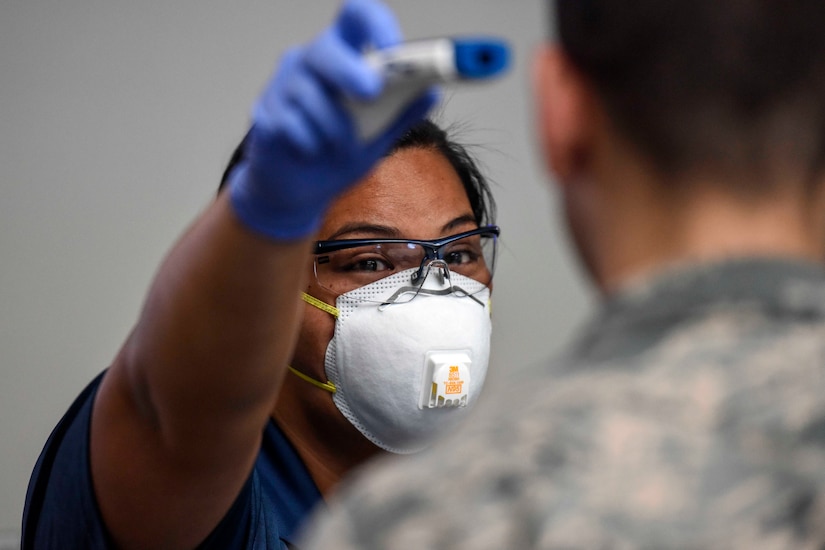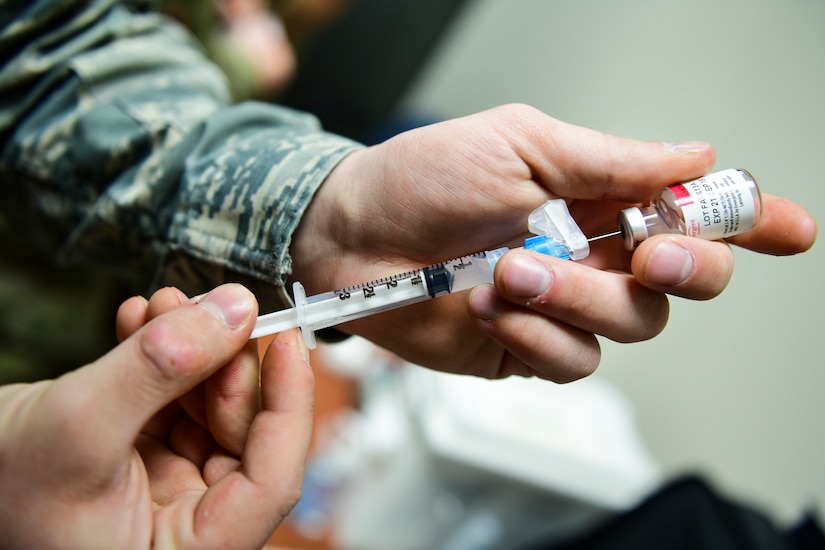Aug. 28, 2020 | , DOD News
Two of the six candidate vaccines for COVID-19 are now in Phase III trials. Each of those trials will require about 30,000 participants, and Operation Warp Speed is about half finished finding participants for the clinical trials, the deputy chief of staff for policy at the Department of Health and Human Services said.
"We're past the halfway point in terms of enrollment," Paul Mango said. "We feel very good about that enrollment in terms of the overall diversity."
He said the population participating, so far, is varied in age and race, as well as among individuals with varying medical conditions.
"We feel very good about those clinical trials," Mango said. "We would expect that two more of our candidate vaccines will go into Phase III clinical trials by the middle of September. Maybe one of those even sooner, though we're feeling good about the fact that we'll have four vaccines in Phase III clinical trials by the middle of next month."
Operation Warp Speed is the program designed to find a vaccine for COVID-19 before the end of the year, and to quickly get a vaccine out to Americans by January 2021. Part of that effort involves manufacturing vaccines before they are even approved for use by the Food and Drug Administration. In the event a vaccine is approved, this means it will already be available for distribution. For those vaccines that are not approved, the already-manufactured doses will be destroyed.

Manufacturing is underway now for three of the vaccines, Mango said. For the other three, facilities are being set up, and manufacturing will start shortly.
"We feel we are absolutely on track, if not a little bit ahead in terms of our overall objective, which is tens of millions [of doses] of safe and effective vaccine approved before calendar year-end," Mango said.
One challenge for meeting the goal of Operation Warp Speed is the logistics of distributing the final, approved vaccine. Planning for that is complicated by the fact that some of the candidate vaccines are single-dose, while others require multiple doses, Mango said.
"We have to deal with the difference between single doses and double doses," he said. "We also have to deal with different storage and transport requirements. So when you add all this up, there's five or six major independent variables, and when you run the number of combinations that we're planning for, it's quite extraordinary."
Another factor, Mango said, is the ancillary material that comes with distributing a vaccine — syringes, hypodermic needles and vials, for instance. He said he's confident Operation Warp Speed is ahead in that area.
"We have hundreds of millions of those already received," he said. "We have hundreds of millions of those that are on order and will be delivered as we approach year-end and into the early part of the new year. So we feel we have the vast majority of our logistical needs either already covered or underway."


Dr. Robert Redfield, director of the Centers for Disease Control and Prevention, also discussed planning where the vaccines will go first when they're ready and who will interact with recipients to administer the vaccine.
"Right now, the CDC is focused on leveraging the existing systems we use every day to deliver vaccines across the U.S., as well as building on state and local planning that is underway around pandemic influenza," Redfield said.
Initially, he said, availability of the vaccine might be limited, and it's important that decisions are made now about which populations should have first access to the vaccines.
"CDCs advisory committee on immunization practices, along with other groups like the National Academy of Sciences, Engineering and Medicine, are evaluating the safety and immunogenicity data of vaccine candidates and examining the epidemiology of COVID-19 in focus populations and will eventually make recommendations about which populations to prioritize for vaccine," Redfield said.
Due to teleworking as a result of COVID-19, adults may not be able to get the new vaccine where they have gotten vaccines in the past — in some cases at their place of employment, for instance, Redfield said.


"A successful vaccine program will require a combination of traditional and innovative approaches to how vaccines are administered," he said. "So pharmacies and other complementary community-based locations may be important in our response to this pandemic."
Redfield also said that a distributor for the future COVID-19 vaccine has been chosen. He said the CDC and that distributor typically deliver as many as 80 million doses of vaccines to providers.
"During an emergency, this system can be scaled and has the capacity to manage and distribute up to 900 million vaccine doses," he said. "Our goal is ensure that there's no delay in the handoff between the FDA authorizing a vaccine and the implementation of vaccine programs nationwide."
Operation Warp Speed is a partnership between the Defense Department and the HHS. Specific HHS components involved include the CDC, FDA, the National Institutes of Health, and the Biomedical Advanced Research and Development Authority.






No comments:
Post a Comment